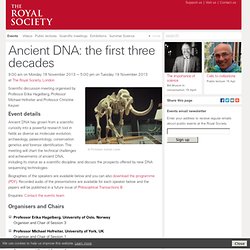

Evolution of humans. Timeline: The evolution of life - life - 14 July 2009. Read full article Continue reading page |1|2|3|4 There are all sorts of ways to reconstruct the history of life on Earth.

Pinning down when specific events occurred is often tricky, though. For this, biologists depend mainly on dating the rocks in which fossils are found, and by looking at the "molecular clocks" in the DNA of living organisms. There are problems with each of these methods. Modern genetics allows scientists to measure how different species are from each other at a molecular level, and thus to estimate how much time has passed since a single lineage split into different species.
These difficulties mean that the dates in the timeline should be taken as approximate. 3.8 billion years ago? This is our current "best guess" for the beginning of life on Earth. . , and was probably based on RNA rather than DNA. At some point far back in time, a common ancestor gave rise to two main groups of life: bacteria and archaea. 3.5 billion years ago 3.46 billion years ago 3.4 billion years ago. Astrobiologists Find Mechanism that May Have Triggered It. The question of how life began on a molecular level has been a longstanding problem in science.

However, recent mathematical research sheds light on a possible mechanism by which life may have gotten a foothold in the chemical soup that existed on the early Earth. Researchers have proposed several competing theories for how life on Earth could have gotten its start, even before the first genes or living cells came to be. Despite differences between various proposed scenarios, one theme they all have in common is a network of molecules that have the ability to work together to jumpstart and speed up their own replication — two necessary ingredients for life. However, many researchers find it hard to imagine how such a molecular network could have formed spontaneously — with no precursors —from the chemical environment of early Earth.
"These results could have major consequences for how we think life may have originated from pure chemistry," Hordijk writes. Image credit: 7 Animals That Are Evolving Right Before Our Eyes. People who doubt evolution tend to have one main argument: "If evolution is true, why do we still see monkeys running around today, all chimp-like?

Where are all the monkey-men I was promised? " Well, if you or someone you know refuses to believe that organisms change over time without proof on a monkey-man level, here are a buttload of animals in the middle of getting their evolve on. Well, seven anyway. Elephants are Evolving to Lose Their Tusks (and Avoid Poachers) The 6 Creepiest Things Hiding in Your DNA. We're all just one impulsive Google images search away from facing the unblinking darkness that lurks within the heart of man.

But that black pit of twisted evil and decay shouldn't surprise anybody; it's rooted in our genetic makeup. Literally. Back in biology class, you were probably taught that DNA was a sensible, organized system. When they called it "the building blocks of life," you probably pictured DNA as a series of neatly edged Legos snapping together to form a cohesive whole. When in reality, DNA is more like an old scrapbook that someone has torn up, pasted back together, filled with old newspaper clippings about murder and then taken into the bathroom with them. Photos.comShe knows what she did. Clues to the Origin of Carbohydrates. "We are trying to understand the chemical origins of life.

One of the interesting questions is where carbohydrates come from because they are the building blocks of DNA and RNA. What we have achieved is the first step on that pathway to show how simple sugars –threose and erythrose—originated. We generated these sugars from a very simple set of materials that most scientists believe were around at the time that life began. " All biological molecules have an ability to exist as left-handed forms or right-handed forms. Ancient DNA: the first three decades. © Professor Adrian Lister Scientific discussion meeting organised by Professor Erika Hagelberg, Professor Michael Hofreiter and Professor Christine Keyser Event details Ancient DNA has grown from a scientific curiosity into a powerful research tool in fields as diverse as molecular evolution, archaeology, palaeontology, conservation genetics and forensic identification.

This meeting will chart the technical challenges and achievements of ancient DNA, including its status as a scientific discipline, and discuss the prospects offered by new DNA sequencing technologies. Missing rock fuelled Cambrian explosion of life - opinion - 21 June 2013. LIFE on Earth experienced a singular revolution just over 500 million years ago.

In a geological blink of an eye, most groups of the animal kingdom appeared in the Earth's oceans and then diversified. The acquisition of skeletons, the advent of predation and the rise of complex ecosystems all occurred in what's known as the Cambrian explosion of marine animals. Life took such a giant leap forward in abundance and complexity during the Cambrian that the rock record itself was indelibly changed. Long before geologists knew the precise age of the Earth, they could divide its history into two parts: the first 4 billion years, known simply as the Precambrian, followed by the Phanerozoic, meaning "visible life", which includes the Cambrian right up to today.
Evolutionary change isn't supposed to happen so abruptly, at least not according to Charles Darwin. Volcanic mayhem drove major burst of evolution - environment - 16 January 2014. OUR planet is home to a glorious variety of animals, but it might not have been.

Were it not for the birth pangs of a mega-continent, the evolution of animals could have stopped at its earliest stages. We now have the best evidence yet that an enormous wave of volcanism, caused by several continents crashing together to form the even greater landmass known as Gondwana, was the reason for a sharp rise in global temperature. This change was the driving force for evolutionary explosions that made life more diverse and laid the foundations for all future animal species. Volcanoes can cause global warming because eruptions often spew huge amounts of the greenhouse gas carbon dioxide. Now a study of volcanic rocks from early in life's evolutionary story shows that such eruptions coincided with a change in the climate from frigid chill to sweltering heat. Last year, a study suggested that microbes helped form continents by encouraging volcanic activity (New Scientist, 23 November 2013, p 10).
Swedish space rock may be piece of early life puzzle - space - 30 June 2014. A fossil meteorite unlike anything seen before has been uncovered in a Swedish quarry.

The mysterious rock may be the first known piece of the "bullet" that sparked an explosion of life on early Earth. Roughly 100 fossil meteorites have emerged from the limestone quarry west of Stockholm, which is being mined for flooring. All of the meteorites are part of an iron-poor class called the L chondrites. They date back about 470 million years to the Ordovician period, when Earth experienced a mysterious burst of new species. Now miners working in the Swedish quarry have found a meteorite fragment that is not an L chondrite. Cloud of destruction About 515 million years ago, our planet was going through an evolutionary slump. The Ordovician: Life's second big bang - life - 11 June 2008.